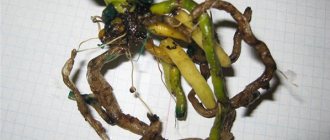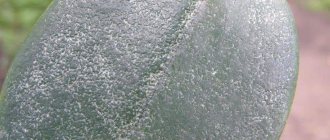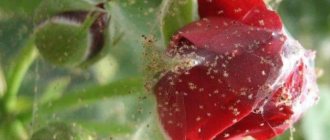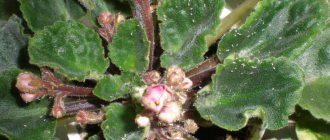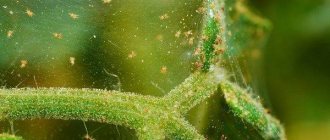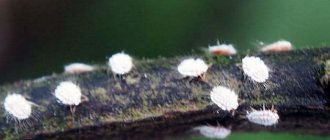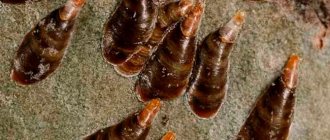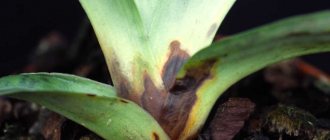Soil mites are an important part of the ecological system. This is a large group of arthropod arachnids living in the ground. Their natural function is to maintain the normal process of organic matter decomposition and soil formation. The soil mite is found everywhere - in the forest, field, meadow or garden. Together with the soil, they end up in greenhouses, greenhouses, and flower pots. When exposed to special conditions, mites become pests that eat roots and other parts of plants. In large numbers, arthropods pose a danger to bulbous plants.
How to deal with root and bulb mites?
When mentioning soil pests, most gardeners immediately think of nematodes.
But the number of soil-dwelling insects that are dangerous to plant health is not limited to them alone. One of the most difficult pests to identify and control is root mites. It does not bother all plants. But for bulbous indoor stars and orchids, it most often becomes the cause of death. Root mites and bulb mites are pests that are considered a specific problem for bulbous plants only. Indeed, these harmful insects are dangerous for your favorite indoor bulbs - hyacinths, hippeastrums, amaryllis, tulips, crocuses and their large and small relatives. But they are also dangerous for another plant that forms pseudobulbs and rhizomes - orchids. They are easily adaptable and reproduce amazingly quickly, are difficult to detect and require drastic measures to combat them.
Bulb root mite (Rhizoglyphus echinopus)
Content:
Description of the pest
The root mite is an amazing creature.
It is constantly present in the soil, but almost no one notices it. But if your bulbous plant dies, you should shake out the soil and examine it carefully. It is easy to recognize by its appearance. This is a light, translucent insect. It is very hardy and does not die without food and moisture. Under unfavorable conditions, his metabolic processes only slow down. But under suitable conditions, they come to life again and begin to feed on roots and bulbs.
The soil mite has very strong jaws. Therefore, insects easily damage the bulb tissue. They lay eggs in the freed space. Gloxinia, hyacinths and orchids are most susceptible to infection.
Features of the life activity of root mites
Root mites include two types of insect pests that literally gnaw at plants (and not always just roots and bulbs):
- A true root mite is Rhizoglyphus echinopus; it is capable of gnawing the entire bulb from the inside, leaving only one shell. This is a small insect, but clearly visible even to the naked eye, with four pairs of legs and a light yellow body up to 1 cm long, tapering towards the end and broadly oval in the “abdomen”.
- The bulb mite - Steneotarsonemus - is a larger insect with an oval white or yellowish body and only two pairs of legs.
Root mites literally gnaw through bulbs, pseudobulbs and root tubers, moving further and further and leaving behind clearly visible destruction - decay products similar to brown dust. They leave noticeable “movements” in the roots of orchids.
But it is very difficult to notice the lesions: most often, root mites settle in the bottom of the bulbs and can be detected only during transplantation or when, due to increasing damage to the bulbs, flowering stops, the leaves and peduncles begin to dry out and you have to resort to an emergency inspection of the bulb. But the insects themselves are quite clearly visible, as are their larvae and eggs.
Root mites actively reproduce at any temperature above 10 degrees (and the hotter it is, the faster they spread). But the most dangerous feature of these pests - unlike most terrestrial insects that are familiar to any owner of a collection of indoor plants - root mites are similar to nematodes: they love high humidity and reproduce more actively in a humid environment.
The difficulty of controlling root mites is largely due to the fact that they survive even in the most unfavorable conditions: females enter diapause (a state of inhibited vital activity), burrowing into the soil or hiding in hard-to-reach places of the plant until the atmosphere changes and favorable conditions for them will not arise. “In hibernation” it is very difficult to detect ticks.
Signs of soil mite infestation
Under favorable circumstances for humans, field mites are located deep in the soil and do not appear on its surface. Only when they multiply rapidly and their quantity exceeds the safety limit, can parasites be found on the soil surface. Characteristic signs of the presence of root mites in a plant are the following:
- white dust on the surface of the earth near the rhizome, and under it there are numerous small passages;
- drying, wrinkling and looseness of the bulbs;
- covering the roots and rhizomes with mold or spots of various sizes;
- looseness and softness of the tubers; when removed from the ground, they crumble or wrinkle easily;
- slowing down of plant growth and deformation of peduncle primordia;
- unpleasant odor of the soil, reminiscent of a putrefactive environment;
- small holes and dark areas can be found on the leaves;
- in the soil mixture you can unearth the shells from the larvae;
- Brown scar tissue is visible on the underside of the leaves.
In general, when infected, a houseplant quickly withers and withers. The soil becomes dry and loose, and watering does not solve the problem of drying out and cracking of the top layer of soil.
Important! If any of the above symptoms occur, the diseased plant should be isolated from other flowers to avoid contamination of healthy soils.
Prevention of root mites
The best method of preventing root mites is to maintain clean topsoil and an optimal environment for plants. You should not leave wilted flowers on the peduncles, and even more so, do not allow fallen leaves to lie, or allow debris to accumulate on top of the substrate (the contaminated top layer can be removed more often, and not only during replanting or in the spring).
Air humidity must be maintained within optimal limits. And wiping leaves or showering for those plants that allow this should not be accompanied by soaking and contamination of the soil. You should always try to maintain the required substrate humidity. Overmoistening, dampness, and stagnation of water in trays are extremely dangerous for all bulbous plants.
Signs of damage to the bulb by root mites. © Doctor Mom
Proper storage of bulbs during the dormant stage is equally important. A cool, dry room with a humidity level of no higher than 40% is the main guarantee that the bulbs, both outside the soil and in pots that are in the dormant phase, will not suffer from these pests.
If you are just purchasing bulbs for planting, it is better to leave them for several days in a cool, dry place and inspect them carefully. But no one is safe from purchasing infected blooming beauties. Therefore, the quarantine period is very important and should be strictly observed.
Simple rules
- Refuse to purchase if new plants are suspicious. When buying bulbs, spread the scales a little. Parasites can be easily seen and the extent of the damage can be assessed. If the seller does not allow you to inspect the bulbs, it is better not to buy them.
- If you use your own plant material, it will need to be dried after assembly. Bulbs of tulip, hyacinth and other popular plants need to be dried for 16 hours at a temperature of +40 degrees.
- Planted plants need to be watered with chamomile decoction at a temperature of +35 degrees. It will be destructive to parasites.
- Before storing the bulbs, you need to dry both the bulbs and the storage. The room needs to be pickled and the bulbs treated with special substances against fungus and mites.
- Temperature and humidity during storage should be reduced. The higher the indicators, the better the conditions for the development of insects. Check your seeds regularly so that if any signs of damage appear, you can take immediate action. It is best to remove the onion and place it separately. If you do not see ticks, then you can observe her condition. If it worsens, it is best to burn the onion.
How to deal with root mites?
Root mites are much more difficult to control. The sooner signs of root mite damage are identified, the better. Indeed, in this case it will be possible to limit oneself to minimal measures for processing the bulb and there is a higher chance of saving the plant. But in any case, we are talking about emergency transplants and procedures that injure the plant.
Related article: Information about grapes: planting, care and cultivation
It is simply impossible to cope with root mites without treating the bulbs themselves. And although there are several more gentle methods of treating pests, most often only fairly aggressive chemicals and treatments help completely get rid of root mites.
Plants that are suspected of having root mites should be isolated from all other crops in the collection as quickly as possible and emergency replanting should begin immediately. In any case, the bulb and roots will have to be completely removed from the soil. The process of cleaning the bulb for inspection includes the following steps:
- Removing all loose soil by hand.
- Final removal of the substrate by gentle washing.
- Inspect the bulb for the presence and severity of damage.
“Clean” bulbs and roots are treated with preparations to combat root mites. Here the approach can be very different, but, as a rule, it is better not to “play around”, but to immediately choose more serious means. The fight against root mites includes several “steps” of treatment - organic or natural remedies and insecticides of various types.
Organic control methods:
- Wipe with soapy water or soak in soapy water. If the lesion was noticed at the initial stage or you want to prevent infection of neighboring plants, then this method can be considered initial prevention. The bulbs are wiped with a strong soap solution or soaked in a strong solution for 1 hour, then washed under running water. This is an ineffective method that will only help at the very initial stage of root mite damage.
- Soaking in a solution of potassium permanganate (similar to treatment with a soap solution).
- Treatment with alcohol. Alcohol is considered the most effective means of combating root mites. But in order to destroy mites in this way, you will have to treat the bulbs with fairly strong alcohol, which in itself can cause burns. Before treating plants, check the reaction of the tissues of the bulb or roots (burns appear only after 2-3 days, so this treatment is only suitable for bulbs at the dormant stage, which can be stored outside the soil). Alcohol with a strength of 40 to 70% is used by wiping the bulbs with a generously moistened swab or lightly spraying. In addition to treating plants, alcohol can be used to disinfect containers, trays and windowsills, especially hard-to-reach places.
- Another gentle treatment method for initial damage is herbal infusions and decoctions. In case of minor damage, soaking or washing will help deal with ticks:
- infusion of 3 crushed cloves of garlic in 1 liter of water (the drug is ready in 3 hours and is effective for 24 hours);
- decoction of cyclamen tubers (1 tbsp per 1 glass of water);
- decoction of nettle leaves (150-200 g per 1 liter of boiling water).
Treatment of bulbs against root mites. © beatrice164
As an alternative to treatment with herbal preparations, you can also consider treating the bulbs with ultraviolet lamps (procedures for 2 minutes, once a week).
All types of natural control methods can be used for bulbs without digging - by watering the soil with solutions and infusions and spraying the plants. But such treatment is only relevant if there is a suspicion of the presence of root mites and in the very early stages of plant damage.
Folk remedies
Folk remedies are very popular and in demand, since they are absolutely safe, but at the same time they help effectively fight pests:
Tansy. To do this, you need to prepare an infusion of fresh or dry tansy. If you have fresh herb, you will need 150 g of herb and 0.5 liters of water, use only boiling water, leave for 20 minutes. When using dry herb, you will need 25 g, add the same amount of water and leave for the same time. Next, the infusion must be diluted with water, maintaining a 1:1 ratio. Used as an effective means to get rid of pests when transplanting flowers. Dip the roots and bulbs into the infusion for at least half an hour.
Wood ash. It is used as a tincture for treating the plant itself, as well as for the top layer of soil. For cooking you will need 1 tbsp. l. pour 5 liters of raw materials. water, leave for 24 hours. Before use, add laundry soap to the infusion, you will need 50 g, it is better to grind it so that it dissolves well.
Alder. To prepare the infusion you will need crushed leaves. You need to take 1 cl. l. crushed leaves and pour 1 liter of boiling water, leave for 1.5 days. The infusion is used before planting flowers; it must be heated to 45°C and the roots should be dipped into it and left for about 8 minutes.
Garlic. This infusion helps repel pests, both soil mites and other insects. The action is carried out thanks to the smell. To prepare, you need to take 2 heads of garlic, peel and chop, then place in a container that is hermetically sealed. Pour 1 liter of water into it and close it, you need to leave it for 5 days, but you need to place the container in a dark place. Before spraying plants, dilute in a 1:1 ratio with water.
These traditional methods not only help get rid of pests, but also have a beneficial effect on the plant itself. Their use helps strengthen the flower, make it more resistant to various types of pathogens that cause diseases and create unfavorable conditions specifically for pests.
Insecticides and acaricides for pest control
But if you don’t want to take risks, the defeat is quite serious, then only two options will be effective:
- Biological products against insect pests. Many modern preparations based on essential oils and extracts from plants, vermicompost, etc. have a systemic insecticidal effect. And they can be successfully used to combat root mites.
- Insecticidal preparations are an effective, but not the most effective method of control. Instead of systemic insecticides, it is better to use more “highly specialized” drugs - acaricides, designed to combat ticks specifically.
Treatment with both biological and chemical insecticidal agents is carried out in the same way: the bulbs are soaked in the solution, strictly following the manufacturer’s instructions for its concentration and duration of treatment. After disinfection, the bulbs are thoroughly dried, and only then they begin to plant.
Any container (even a new one) in which an onion that has been treated against root mites will be planted will have to be disinfected. For cleaning, use either alcohol, boiling and scalding, or a solution of insecticides.
Only fresh soil is used for planting, preferably from ready-made purchased substrates with a guarantee of treatment against soil pests.
Whatever method of control you choose, in the process of fighting root and bulb mites, you must remember the basic principles of treatment:
- treating only the affected parts or areas is ineffective: all roots and the entire surface of the bulb should be soaked or wiped, and not just the bottom;
- these pests adapt very quickly, and in order to cope with severe lesions, especially if infection occurs repeatedly, you need to alternate and constantly change medications;
- a solution of any drug, even a biological or herbal infusion, is prepared and used within 1 day;
- before treating with insecticides and acaricides, the bulbs must be thoroughly cleaned and washed;
- It is better to wash the window and windowsill on which the infected plant has stood and will stand daily;
- You should never forget about personal protective equipment, if necessary, wear not only gloves, but also a full set of protective clothing with goggles and a respirator, always treating your hands and face with soap after contact with any preparations to combat root mites.
Related article: Amaranth plant family: list, description, genera and species
Signs of damage to the bulb by root mites. © Doctor Mom
Bulbous plants that have “survived” treatment against root mites need not just high-quality, but more thorough care. They need to be watered very carefully. Air temperature and lighting must meet the requirements of the plants. Such bulbs will not be able to fully recover as quickly as after a regular transplant, so it is better not to rush into feeding and stimulating flowering.
Can soil mites cause harm?
Such individuals settle on root crops, bulbs, and tubers. They also feed here (on the pulp of the underground parts of plants, sucking out the juice). Usually such arthropods are beneficial. But sometimes, when exposed to special conditions, ticks cause some harm. They are found in meadows, fields, and vegetable gardens.
Here, the earth mite is invisible at first; it performs its usual functions of maintaining the process of soil mineralization and decomposition of organic matter. However, the number of earthen arthropods is gradually increasing.
This leads to
that mites become pests: the intensity of the process of decay of plant residues and organic substances increases, which contributes to the appearance of an unpleasant odor from the soil and plants.
In addition, other troubles associated with increased activity of arthropods and the growth of the number of their colony are noted:
- gradual erosion of the roots, and therefore damage to the seedlings;
- spread of pathogenic microorganisms (bacteria, fungal spores);
- destruction of planting material.
Pests can be dangerous to people. They provoke the development of allergies and disrupt the functioning of the human intestines and genitourinary system.
Such ticks are found in meadows, fields, and vegetable gardens
Root mite on houseplants
Root mite pests are certainly dangerous, but fortunately they are not as omnivorous and less common than whiteflies, spider mites or aphids. But if a root mite appears, expect trouble. If timely measures are not taken, very serious harm will be caused to the plant. The situation is aggravated by the fact that this pest is not very easy to detect. The root mite hides in the ground and gnaws the roots of the flower. It is dangerous for many indoor plants, but it especially likes orchids and bulbous plants. Gnawing on the bulb, the mite moves between the scales, affecting it more and more.
Causes of root mites
- The first reason is non-compliance with watering rules. If the plant is flooded, the soil is constantly damp, and the room is warm, then these are ideal conditions for its existence.
- The second reason is the migration of root mites from an infected plant to a diseased one.
- And the third reason is purchasing an already infected plant.
Although I have divided the reasons for the appearance of root mites, they can all be combined into one chain. First, an infected plant is purchased, quarantine rules are not followed, the pest migrates to a healthy flower, and there are ideal conditions for it with wet and warm soil.
Signs of root mite infestation
There are no obvious external signs that the flower is affected by a mite. The plant just withers and that's it. But if all care rules are followed and no other pests are found, then you need to inspect the roots and bulb. The root mite is clearly visible to the naked eye. They are relatively large, spider-like with three pairs of legs and a transparent body. It is quite simple to understand that the bulb is affected. You need to squeeze it slightly. The root mite eats the bulb from the inside. Such a bulb, if severely damaged, will begin to fall apart in your hands, and dust will begin to fall out of it, both the root mites themselves and their larvae.
Preventive measures against spider mites
In order not to wonder how to deal with spider mites, it is necessary to prevent their appearance. For this purpose, preventive measures are observed.
- The soil between the rows of plantings must be weeded regularly, removing any weeds from the area.
- Ticks reproduce well at humidity levels of 30-50%. If you water the plants often, but little by little, the pest can be avoided.
- Complex minerals containing a lot of phosphorus and potassium are used for fertilizing. They make plants more resistant to external, negative influences.
- For prevention, crops are sprayed with garlic infusion. Preventive treatments are done approximately 2-3 times per season. To make an infusion, 2 heads of garlic are chopped or crushed and filled with a liter of water. After 5 days, you can use the infusion for its intended purpose.
Spider mites multiply quickly, spreading to a wide variety of crops. Of course, it can be removed if such a problem occurs; special drugs are used for this. But it’s even better to prevent the pest from appearing on garden crops and favorite flowers.
Root mite control
The most common type of these pests is the bulb mite. Therefore, the greatest attention should be paid to bulbous plants. If you find a mite on the bulbs or are affected by them, soak them in a solution of the appropriate preparation. Which one to choose, decide for yourself. A lot of drugs have been created to combat root mites. Before soaking, thoroughly clean the bulbs from the soil and wash them with warm water. The soaking time depends on the drug and is indicated on the package. The pot must also be treated. It must be thoroughly washed and treated with the same preparation against root mites. And if possible, it is better to boil the pot.
Note. From the moment the plant becomes ill, regardless of its cause, until the end of treatment, separate the flower from healthy plants. It is better to carry out the treatment in the fresh air or in a non-residential area.
Prevention
- Store plant bulbs only in a dry and cool place.
- Before planting and during transplants, carefully inspect the roots and bulbs of plants.
- Make sure to water correctly. Excessive watering is no less, and often more, destructive to flowers than drying out the soil.
- Drain the water from the pan after watering. It should not remain in the pan.
- To avoid stagnation of water in the pot, be sure to create good drainage when planting and replanting flowers.
Note. Root mites are dangerous not only for indoor plants. If you grow garden flowers on your property, then keep an eye on them. It is especially dangerous for gladioli, tulips, hyacinths, lilies and other bulbous plants.
Where does the problem come from?
The ideal condition for the appearance of soil mites in indoor plants is warm and waterlogged soil. Therefore, if you tend to flood pots, then the risk of mites increases several times. Ticks quickly crawl from one pot to another. Therefore, infected plants must be destroyed or isolated from healthy ones. A good way out of this situation would be immediate treatment, as well as parallel prevention among healthy plants. The easiest way to get a mite into your collection is by buying bulbs or substrate in the store that already contains the parasite.
Let's get acquainted with acaricides - drugs to combat plant mites
All summer residents should remember the rule of nature: “there is food, therefore there are eaters.” This applies to any plants, but it becomes especially important for those that people use for food.
No matter how beautiful and elegant the lush May greens of strawberries or cucumbers look at the time of the beginning of flowering, you need to take a close look at the leaves: suddenly tiny pests have already colonized the folds and the underside of the leaf blades.
How to deal with those who are invisible? Know the biology of the pest and understand acaricidal drugs .
What ticks are harmful in our gardens and vegetable gardens?
If there were ticks last season, they did not disappear in winter. In the spring, when it warms up to +12 degrees Celsius, the common spider mite will come out of winter. The female will lay 150 eggs, from which males and females will hatch, continuing a series of new incarnations. Summer offspring will be only male.
From spring to mid-summer, ticks live on quinoa, nettle, bindweed, and then move to apple trees. As soon as the length of daylight hours becomes equal to 14 hours, only females begin to hatch from the eggs, which will go to wintering. In the spring they will become the founders of new colonies of pests.
Article on the topic: Perennial flowers - planting and care, names and photos, flowering and deciduous
The hawthorn mite leaves its wintering grounds when the temperature rises above +10 degrees Celsius. These arthropods parasitize apple, pear, cherry, plum, peach, and sweet cherry trees.
The red fruit mite lays eggs in the fall; in the spring, new individuals emerge from them, which will be able to lay eggs at the time when the apple trees begin to bloom. These types of mites harm apple trees, pears, plums, cherries, apricots, almonds, roses, rowan trees, and hawthorns. If this pest has not been talked about, this does not mean that it is not in Siberia, Western and Eastern Europe, and the Far East. But it definitely exists in Crimea, on the Caucasian Black Sea coast.
The onion root mite lives in all territories of Russia. It damages the underground organs of bulbous crops, and not only garlic and onions, but also tulips, hyacinths, lilies, and gladioli. If the bottom of the onion becomes so rotten that it can fall off, the onion mite has worked. The developmental features of insects allow the pests the onion hoverfly and the onion secretive proboscis to spread mites to all the plants in your area.
When to start a war and how to process plants
It is easier to deal with ticks while they have just “emerged” from the egg, while they are still considered young larvae. Later, the larva and adult tick are more resistant to toxic substances, although there are drugs that can destroy even eggs. That is, the timing of treatments against ticks is now becoming clear.
Alf Ribeiro / Shutterstock.com
All dosages are written on the packaging, but you need to spray carefully. The leaves and stems need to be moistened with the working solution thoroughly on all sides so that the “medicine” gets to each tick. Then the effect will be wonderful.
Acarid mites - pests on tubers and bulbs
Representatives of the family of acarid or grain mites can be found in various places - apartments, granaries, and on the human body. They are also present in the soil. Two types of arachnids live on the roots and tubers of plants:
- Tyrophagus - elongated mites;
- Rhizoglyphus - bulb mites.
Rhizoglyphus
The root bulb mite is widespread in all countries. It is a polyphagous organism that eats various types of food. The pest's diet includes onions, potatoes, grape roots, cereals and ornamental crops. The body is elongated, yellowish in color. The legs are short and thick, each with large spines. The length of an adult is 0.8-1 mm.
Through mechanical damage, the mite penetrates the bulb and feeds on its juice. If there are no holes, then it gnaws the road with strong claws. In regions with a warm, humid climate, decorative flowers in open ground and greenhouses are at risk. In damaged gladioli, tulips and daffodils, the growth process slows down. They can be infected with various diseases.
The pest is very moisture-loving; it thrives at 100% humidity. Its life processes accelerate with increasing temperature - at +150 the nymph develops in 22 days, and at +250 – 2 days. The female onion mite lays from 200 to 800 eggs. After 7-10 days, larvae emerge from them. The lifespan of adults is 2 months. But the pest also feeds in the early stages of development.
Tyrophagus
The elongated putrefactive mite causes no less damage than the onion mite. This pest under normal conditions lives deep in the ground. When humidity levels are high, it leaves the ground and moves onto the plant. The mite damages the leaf blade; it prefers to settle on young shoots.
Signs of soil mite damage include:
- the appearance of spots on the surface of the plant bulb;
- drying of the bulbs;
- the inside of the tubers turns to dust;
- the appearance of punctures on the leaves;
- a brown coating of scar tissue on the underside of the leaf blade.
The main measure to combat elongated and root mites is humidity control. To destroy the pest, plants are treated with Fitoverm. The soil is sprinkled with powders and granules - Sunmite, Nissoran. Bulb planting material should be stored in a dry place. They are warmed up before storing. Material with external damage is immediately removed.
Ammunition in the war for plant life
- Lambda-cyhalothrin. Synonyms: Karate, PP 321.
This substance was discovered in 1977, and in 1985 it was already used against beet and rapeseed flea beetles, aphids, sawflies, and meadow moths. Within 24 hours, the drug destroys a significant part of the colony of harmful insects. It does not destroy ticks, but their development is suppressed, and the number of the pest does not grow. The waiting period after treatment is one month or ten days more.
List of drugs that contain only lambda-cyhalothrin: Lightning, Gideon, Gladiator, Diplomat, Kaizo, Altyn, Karatoshans, Karate, Zeon, Karachar, Kungfu, Lambda-S, Lambdex, Operacot, Samum, Sensei. Each liter of the drug contains 50 grams of the active substance lambda-cyhalothrin.
There are drugs in which other active ingredients are added to lambda-cyhalothrin. These are Ephoria (Aktara 106 g/l + lambda-cyhalothrin 141 g/l), Boreas, Clotiamed Duo.
- Malathion. Synonyms: Aliot, compound 4049, phosphothione-50, drug 4049, (long-familiar and forgotten) karbofos , malaton, kipfos, AS-4049, FOG-3.
The substance in 1950 in the USA was called T.M. 4049, in 1953 it was renamed malathion, and in the USSR it was obtained in 1952, called karbofos.
List of drugs that contain malathion, also known as karbofos: Aliot (570 g/l), Bunchuk, Karbofos-500 (500 g/l), Iskra M, Antiklesch (525 g/l), Novaktion, Fufanon Expert, Fufanon Nova (440 g/l).
Anti-mite in a dilution of 10 milliliters of the drug per 10 liters of water is used to treat raspberries, apple trees, tomatoes and cucumbers in greenhouses against spider and fruit red mites during the growing season, taking into account flowering and harvesting.
- Clofentezim. Synonym: Apollo.
This substance acts on eggs and larvae, and makes adult ticks sterile. They don't die, but they can't reproduce. It is beneficial to treat apple trees with Apollo; the substance is most active on this crop. In addition, it works well on grapes and strawberry mother plants.
- Phenpyroximate. Synonyms: Danitron, Ortus, NNI-850.
The drug Ortus for home gardens is not registered, although it quickly leads to paralysis of gall and spider mites. Used for processing apple trees and grapes.
- Phenazakhin. Synonyms: demitane, EL-436.
The substance is not new. It was registered in 1993. Back in 1994, it was tested in vineyards in Crimea. The drug Demitan is not registered for private households. This acaricide destroys gall and spider mite larvae at any age and is used to protect apple trees and ornamental plants.
- Bromopropylate.
The drug Neoron was re-registered in November 2003. It is low-toxic for bees, so you can spray plants even during flowering, for example, apple trees and grapes. Effective against many ticks. At the same time, it is capable of destroying hawthorn moth eggs.
In addition to the active ingredients described, there are others. For example, the drugs Semaphore and Talstar are produced based on bifenthrin (Talstar) , Tiovit Jet and sulfur block FAS are produced based on sulfur , and Akarin is produced based on Avertin .
The role of soil mites in nature
The main function of such pests is to maintain the process of mineral turnover in the soil. Thanks to them, soil mixing is ensured. Earth mites also help process organic residues. The implementation of all these tasks allows vegetation to grow in accordance with the natural development periods, receiving all the substances necessary for this.
Soil mites process vegetation that is susceptible to rotting, the remains of parasites, excrement, and fungal spores. They digest such food, as a result of which fertile humus is formed. The number of soil arthropods per 1 m2 is 50-250 thousand individuals. They are found in the surface layers of the soil.
Young ticks in the soil
Principle of drug selection
Before going to the store, write on a piece of paper the names of substances that are effective, recommended and registered as acaricidal agents. It doesn’t matter what the drugs are called, the essence of which is these active ingredients.
In this case, you can avoid purchasing duplicate products with the same active ingredient. And the seller will not be able to advertise a long-known product as a new product.
Sources:
https://www.botanichka.ru/article/kak-borotsya-s-kornevyimi-i-lukovichnyimi-kleshhami/ https://dcactus.ru/kornevoj-kleshh-na-komnatnyx-rasteniyax/ https://7dach. ru/VeraTyukaeva/znakomimsya-s-akaricidami-preparatami-dlya-borby-s-rastitelnymi-kleschami-88609.html
Types of mites that live in soil
Ticks are the largest group of arachnids. 54 thousand species have been described, most of which live in the upper layers of the soil. These animals have microscopic sizes ranging from 0.2 mm to 1 mm. Their body is solid, there are 6 pairs of appendages. The anterior pairs transformed into oral organs - chelicerae and pedipalps. The remaining 4 pairs are legs.
Based on the nature of their diet, they are divided into several groups:
- saprophages - species that feed on organic remains of plant and animal origin;
- phytophages – arthropods that eat plant tissue;
- predators - mites that prey on small insects, invertebrates, nematodes, etc.
Oribatid mites (Oribatida) are the dominant species among soil inhabitants. They go through 5 phases in their development. At the adult stage, they are resistant to various external influences due to the presence of a hard shell. Living and dead plants, mushrooms, and lichens are used as food. There are no parasites among oribatid mites.
Information. The number of Oribatida in the soil reaches 100 thousand individuals per 1 square meter. m.
In addition to oribatids, hundreds of species of mites live in the soil, helping to process organic residues. Their life activity is closely related to microflora. Soil mites eat bacteria, fungal spores, and algae. Their population increases in spring and autumn, when the ground is abundantly moist. During the dry summer period, the arthropod population declines.
The neighbors of saprophagous mites are predators. These individuals are larger in size than their herbivorous relatives. Representatives of the family Bdellidae reach 3.5 mm. These are free-living individuals with a soft body and a growth on the head in the form of an elongated nose. Its diet includes small arthropods and insect larvae.
Preventing the appearance of parasites in the apartment
Following preventive measures will help save plants and prevent pests:
- regularly check flowers for damage and parasites;
- keep new plants in quarantine for 2 weeks;
- install mosquito nets on the windows;
- do not allow the flower to dry out, spray it regularly, since mites cannot tolerate high humidity;
- remove fallen leaves and buds in a timely manner;
- carry out preventive treatment with protective drugs, wipe the leaves;
- disinfect the soil before transplanting flowers (freeze or evaporate).
Spider mites are a dangerous pest that in a short time can form a large colony of parasites that destroy house plants. Insecticides and folk remedies will help preserve the beauty on the windowsill. To prevent the problem from recurring, follow preventive measures, create unfavorable conditions for insects and provide proper care for the flowers.
Ways to get into a flower pot
To detect soil mites, you need to remove the indoor plant from the pot; in open ground, dig a small hole near the root system and inspect the contents of the soil.
Reasons for the active reproduction of soil mites in indoor flowers:
- frequent and abundant watering;
- lack of drainage and removal of excess liquid in flower containers;
- improper placement of crops (near heating devices);
- old stagnant substrate;
- planting weakened, damaged bulbs, infected seeds;
- highly compacted multicomponent soil mixture that does not allow air to pass through;
- improper storage of planting material.
According to the nature of their feeding, ticks are divided
Pests are divided into several groups. This is facilitated by differences in eating habits. Microscopic mites do not have a powerful mouthparts. For this reason, representatives of some species first spread the infection and then begin to feed on the tissues of weakened plantings. The feeding process of predators follows a similar principle.
But the pincers
They introduce special substances along with saliva that liquefy the tissues of insects and other arthropods.
Saprophages
This is the name given to individuals that receive the necessary nutrients after the death of a plant or living organism. They don't harm people. On the contrary, such individuals contribute to soil mineralization.
Root mite inhabits
of this species in the ground, eggs and larvae appear here.
Phytophagous
The source of food for such individuals is plants at different stages of development. Pests destroy above-ground and underground parts of plantings. This group includes a large number of varieties. Another name for such individuals is herbivores. The danger of phytophagous pests lies in their small size. This prevents them from being detected in a timely manner. The principle of eating is based on the ability of mites to pierce the outer shell of plants, then with the help of a proboscis they suck out the juice, which leads to the weakening of flowers and crops and their death.
Predators
Ticks of this group consume mainly other individuals: insects, invertebrates, nematodes, and even representatives of other types of arachnids. They rarely cause harm to people, as they differ in feeding habits from blood-sucking individuals.
On the contrary, they are beneficial
– contribute to the natural control of the number of colonies of parasitic individuals.
Family of soil mites
